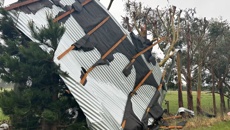Gabrielle is likely to squash local sea level pressure to the lowest values ever observed in New Zealand – one of several indicators the incoming ex-tropical cyclone will be packing plenty of power as it rolls through over the next three days.
Its wind-making potential - already being demonstrated with gusts higher than 140km/h at Cape Reinga - may also be worsened by the formation of a scorpion tail-like feature called a “sting jet”.
MetService has issued 19 heavy rain and wind warnings across the North Island, with hundreds of millimetres possible for exposed locations like Coromandel and parts of the East Coast.
Red heavy rain warnings are in place for Northland and Gisborne, while orange warnings for heavy rain and strong winds are active for most other regions across the North Island.
Record-breaking pressure
Overnight, Niwa scientists calculated that Gabrielle could break mean sea-level pressure (MSLP) records in or near New Zealand early on Tuesday.
As Niwa meteorologist Ben Noll explained: “The tighter the pressure-packing, the stronger the winds, the more intense the weather.”
Just as it sounded, MSLP measured atmospheric pressure at mean sea level.
In weather reports and TV forecasts, it’s represented through isobars joining together areas with the same MSLP (or weight per square area of the air above) and sometimes indicated in pressure-measuring units called hectoPascals (hPa).
Winds tended to blow directly along these isobars, and the closer they were grouped together, the stronger those winds would be.
Tightly-aligned circles of isobars of course denoted low pressure systems, which acted like giant funnels of winds spiralling inward and upwards, forcing warmer air in the centre to rise, before cooling and creating cloud.
- Metservice Meteorologist: Sunday is Cyclone Gabrielle's warm-up day
- Cyclone Gabrielle: Air New Zealand asks all passengers to reconsider travel
- Why this storm could be worse: High winds to cause power cuts, downed trees, more slips and surges
- Cyclone Gabrielle: What you need to do now to get ready
In moderate low pressure systems, hPas dropped from a standard 1013hPa to between 1000hPA and 980hPa – while deep or intense lows associated with heavy storms carried values below 980hPa.
Early on Tuesday, Gabrielle’s minimum central pressure could plummet as low as 961hPa.
While there’d been several cases of pressure levels falling to around 970hPa in some 170 years of records, local values forecast for Gabrielle appeared to be unprecedented.
At the least, meteorologists were placing Gabrielle’s potential values in the same territory as the “North Island Weather Bomb” of July 2008, in which Cape Reinga measured 963hPA, and the infamous New Zealand cyclone of 1936, where barometers in Auckland pointed to 973.3hPA.
The destructive Cyclone Bola of 1988 registered around 980hPa, while 1968′s Giselle – which led to the Wahine disaster in Cook Strait – brought levels as low as 964hPa in Wellington.
“With Gabrielle, it’s looking quite likely that it’s going to deepen or intensify just as it tracks immediately east of Northland and Auckland, or maybe around the top of the Coromandel,” Noll said.
“And that deepening and slowing right around the northern New Zealand is what’s causing concern for forecasters in terms of the amplification of those intense rain and wind impacts.”
Noll said this deepening was being caused by an area of “spin” in the mid to upper parts of the atmosphere - and being sourced from the Tasman Sea - that was being integrated within the system’s circulation.
“As that spin gets wrapped into what’s left of the cyclone’s circulation, it causes the wider system to slow down and intensify,” he said.
“This just goes to show that when we’re tracking cyclones in New Zealand, it’s not just the cyclone itself that can cause damaging impacts.
“Because we live in the mid-latitudes, we have to consider other pieces of energy that can come in and make things worse.”
The ‘sting jet’
One such piece was a feature called a sting jet that Gabrielle appeared to be developing now, after its pressure bottomed out at around 958 hPa near Norfolk Island overnight.
This element – notably seen in Auckland’s disastrous April 2018 storm - occurred when a zone of strong winds, originating from within the mid-tropospheric cloud head of an explosively deepening depression, were powered up as the jet descended, drying out and evaporating a clear path as it dropped.
This evaporative cooling led to the air within the jet becoming denser, which in turn led to an acceleration of the downward flow.
The jet then began to hook around the system’s centre - much like the sting from a scorpion’s tail, hence the name - bringing more damaging winds.
As it happened, the spin area coming in from the Tasman Sea was wrapping into the system and intensifying winds on the southern and western side of the cyclone.
Overnight tomorrow, as the system tracked close to the North Island, a jet of wind in the lower part of the atmosphere was likely to increase and then wrap around the system – giving the sting in its tail.
“Again, we need to consider that when cyclones track into our region, their structure changes - and what they’re influenced by changes as well.”
The ‘inverted barometer’ effect
Meanwhile, Noll said Gabrielle could also bring an effect that temporarily raised our local mean sea level.
That came as forecasters were warning of big seas around New Zealand’s north-east coasts – and particularly off Wairarapa, where combined waves could reach 7m high on Tuesday afternoon, and north-east swells could rise to 6m.
“Big winds are typically associated with big seas, and this just goes back to the energy we see in these systems,” Noll said.
“But there’s another phenomenon at play here known as the inverted barometer effect, which happens when very low air pressure forces the sea to rise.”
A difference of just one hPA could correspond to 1cm of sea level height: although this didn’t happen cleanly and immediately, but in an average sense and over a large area.
While it was rare for air pressure alone to drive sea levels any more than 30cm higher (or lower, in high-pressure environments) the effect compounded the impact of wind-driven storm surge.
“So, in addition to the waves, this will be raising that sea level even higher,” Noll said.
“Where we’ve seen wave-overtopping in the past – places like eastern Coromandel, and eastern Auckland, including Tamaki Drive – are likely to see that happen again with Gabrielle.”
Take your Radio, Podcasts and Music with you









